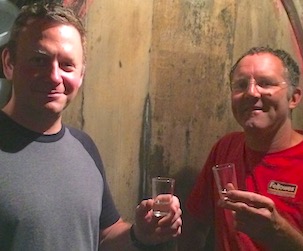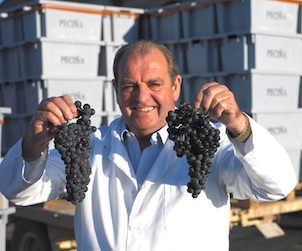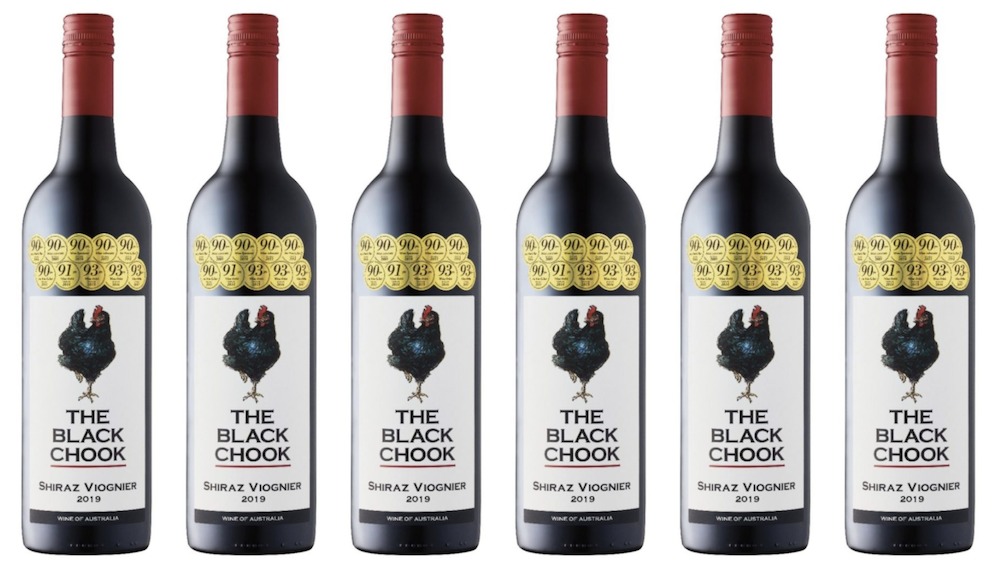The Nebbiolo Prima event began on a Sunday with a gentle and pleasant meet and greet for participants, journalists, winemakers and their families and for the leaders of the governing appellation. This year we were hosted at one of the most historically important fortified palaces in the Langhe, the Castello di Guarene, with its grand architecture and interior of hand-painted murals and handmade textiles. The entire edifice is a work of art dating back to the mid- 1700s
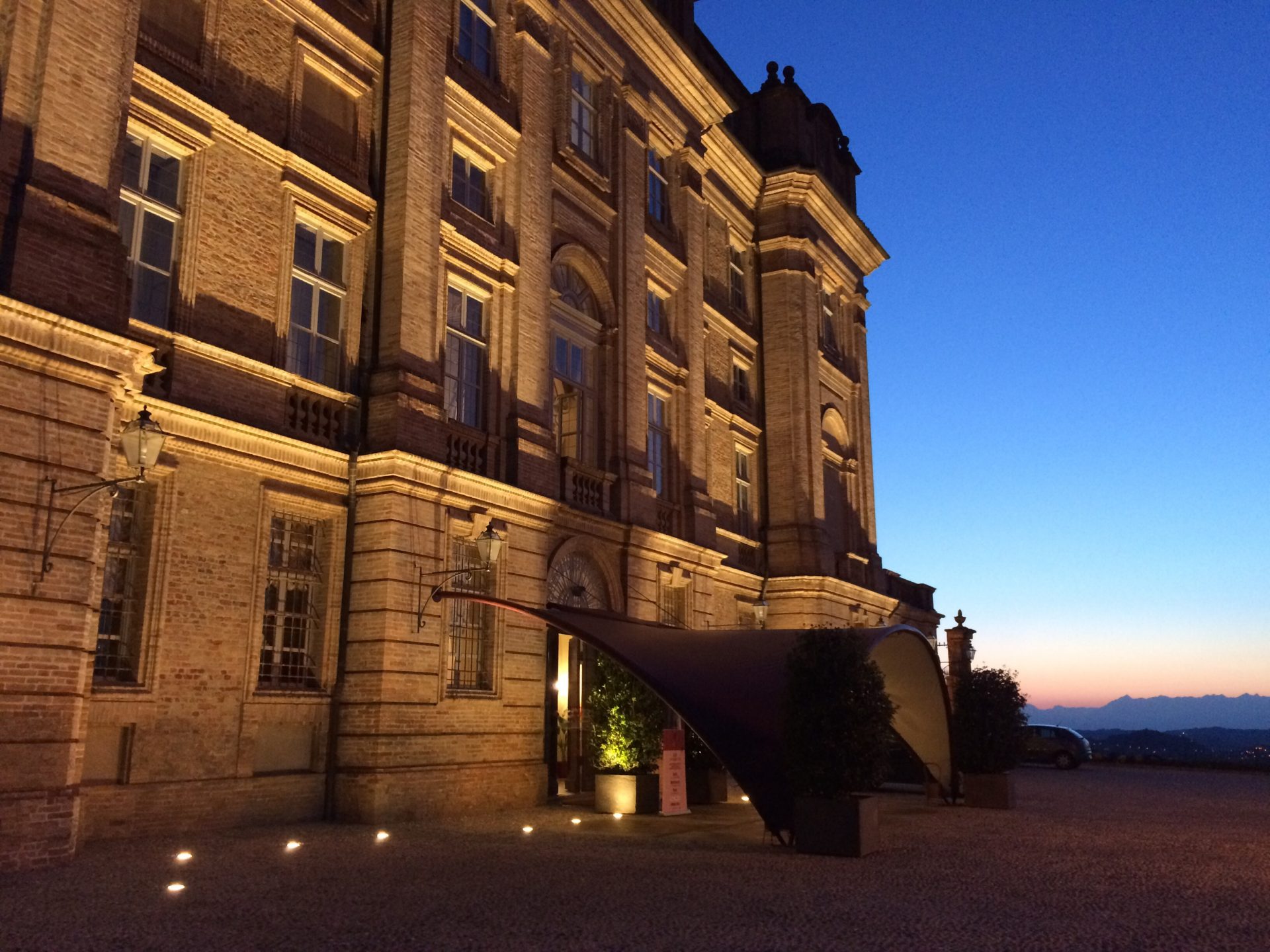
The Castello di Guarene
While the journalists and Piemonte wine people mingled on the garden terrace, I had the opportunity to catch up with an old friend, Mario Andrion, a winemaker from Castello di Verduno. Castello di Verduno makes some of the most characterful and elegant wines in the region in both Barolo and Barbaresco, and Mario, as a student of geology with both perspective and experience on vineyards in both great appellations, engaged me in conversation regarding soil and geology and on what makes Nebbiolo from Piemonte so unique.
I remarked on how curious it is that Nebbiolo does not transmit the same exquisite character when the grape is raised outside of its native home despite the fact that many of the worldly ‘noble’ variety – Syrah, Pinot or Cabernet – seem to perform well abroad. I think it must be the link between soil and, of course, climate combined with something that is particular to the hills of the Langhe.
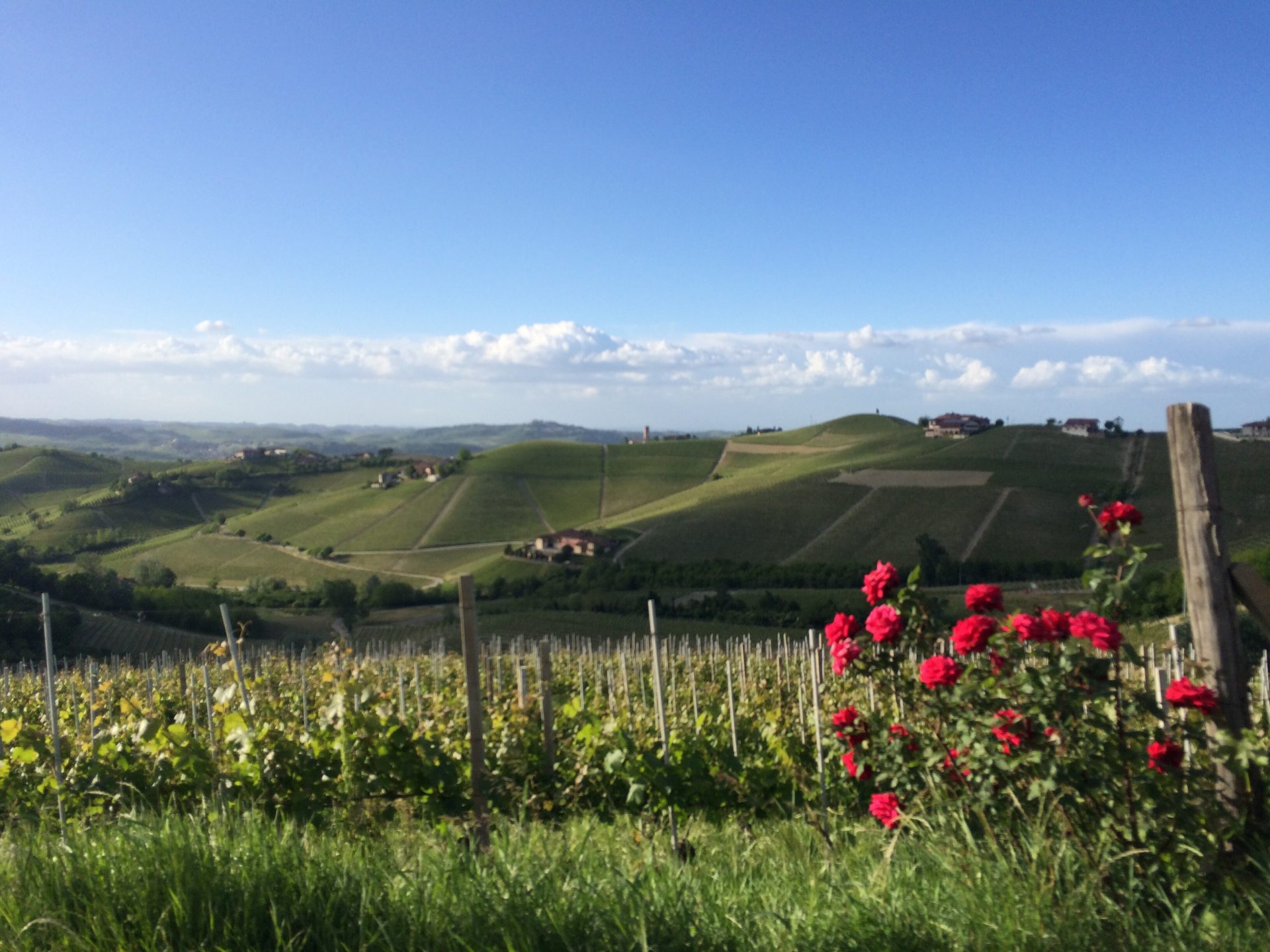
The rolling hills of Barbaresco.
A myriad of unique microclimates exist throughout these hills, which are expressed in the different aspects to the sun, the elevations and the grade of soil; indeed, the region is so diverse that you can taste differences in wines from vineyard to vineyard even within the same general area. In fact, a few days after the reception, I sat down to a round-table discussion with Mario and five other Barbaresco producers to discuss the differences in cru vineyards – soil, exposure, terroir and the unique expression in the wines. The round table shed light on the fact that Barbaresco is equally diverse as Barolo in its terroir and its wine. One can produce hauntingly beautiful wines and equally tannic and robust wines all within Barbaresco. It is true that the nearby Tanaro River provides a warming element to ‘specific’ vineyards to create riper grapes and more approachable wines, but as I learned, there are vineyards in the east and south-east zones of Barbaresco that have more in common with Barolo than they do with the central and north zones of Barbaresco.
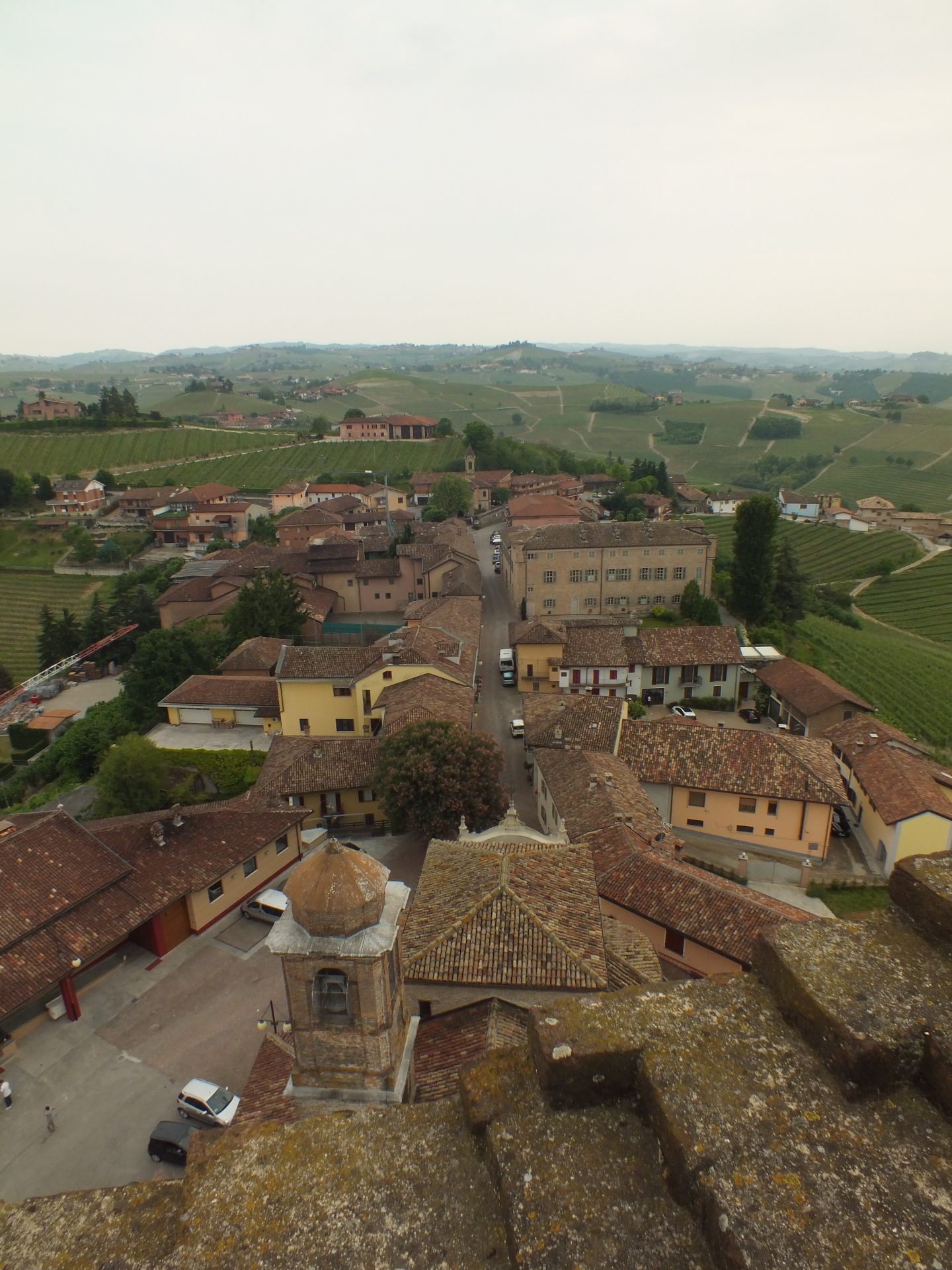
From the Tower of Barbaresco.
After my conversation with Mario, I learned that soil age is a massive contributor to the qualities of the grapes raised and thus to the wine. A quick glance at the trio of major appellations for Nebbiolo production, can be summed up in a simple analogy with a maritime coastal area: imagine Roero* (the third major zone for the production of Nebbiolo wines: Roero DOCG) with its sandy and multi-layered soil, as an all-sand beach producing lighter and gentle wines from Nebbiolo. Although some characterize these wines as simple, I would say they are more subtly nuanced. The Tanaro River and the Town of Alba act as the division and transition point for soils and climate. Returning to our analogy, imagine the receding tides as they pass over the Barbaresco area and consider the warm-cool shallow sea bed and plateau made up of a combination of soils, from limestone to the famous Tortonian calcareous marl mixed with sand, which produce fragrant and supple wines. Moving slightly south to Barolo would be like diving into a deep cold sea of underwater hills and valleys that have soils of overlapping calcareous marl, Helvetian sandstone and, as we move further into the southern communes, of iron-rich clay mixed with limestone. It should be noted that Barolo is a region so diverse that it produces wines ranging from the perfumed and potent to the deep, rich and tannic.
When you look at the map of Piemonte, with the province of Liguria directly to the south and the close proximity of the Ligurian Sea, this notion of oceanic movements and soil development is one that can be further explored.
NOTE: This is obviously a very simplified look at the regions, and there are many nuances within each zone and producer, style and vintage, as well as conditions, which can change the resulting wine.
This was a more complicated geological response than I expected, but it nonetheless fuelled my curiosity to understand the wines of the region more intimately.
Coles Notes:
Barbaresco DOCG has 4 communes. Communes help divide and provide geographical context for the producers and for the wines they make. The three most important communes are as follows; each are crowned by three villages of the same name:
Barbaresco, (wines are ripe to dense often with the ideal balance of fruit and depth)
Neive (wines are variations on the theme of Barbaresco)
Treiso (wines are more full-bodied).
Although the wine profiles on the palate may seem more uniform then different in their youthful approachability, there are many exceptions to this rule:
Barolo DOCG has several distinct communes, 11 in total. The key ones to remember are:
La Morra and Barolo (wines are fresh and perfumed; Pinot Noir in style, I’d say like Gevery-Chambertin, and they share stylistic properties of some Barbaresco)
Castiglione Falletto, which bridges towards Monforte d’Alba and Serralunga d’Alba (the deep and brooding wines)
Part 2: The Gathering at the Tower.
The Nebbiolo Prima event was an opportunity to taste new releases of Roero, Barolo and Barbaresco, and for the more studious, the chance to study and explore. As a result of the tasting I was able to examine the communes of the two major appellations. Each morning I tasted 70 to 100 wines, where I was given the communes and single cru vineyard origin but not the producers. This allowed us to rate and score the vintage and the region rather than play favourites with our preferred producers
The afternoon was spent touring vineyards and to that end I had planned my visits to correspond with wines I would have tasted in the morning only this time we would meet the producer and further understand the wines.
On this trip my first significant day of tasting and scheduled visits was to vineyards of the Langhe was in the region of Barbaresco. I signed up for the ‘Round table discussion of Barbaresco’ with six producers representing all three communes of Barbaresco. A small group of us convened for this tasting at the foot of the Tower of Barbaresco, an historic and now restored example of Piemontese architecture.
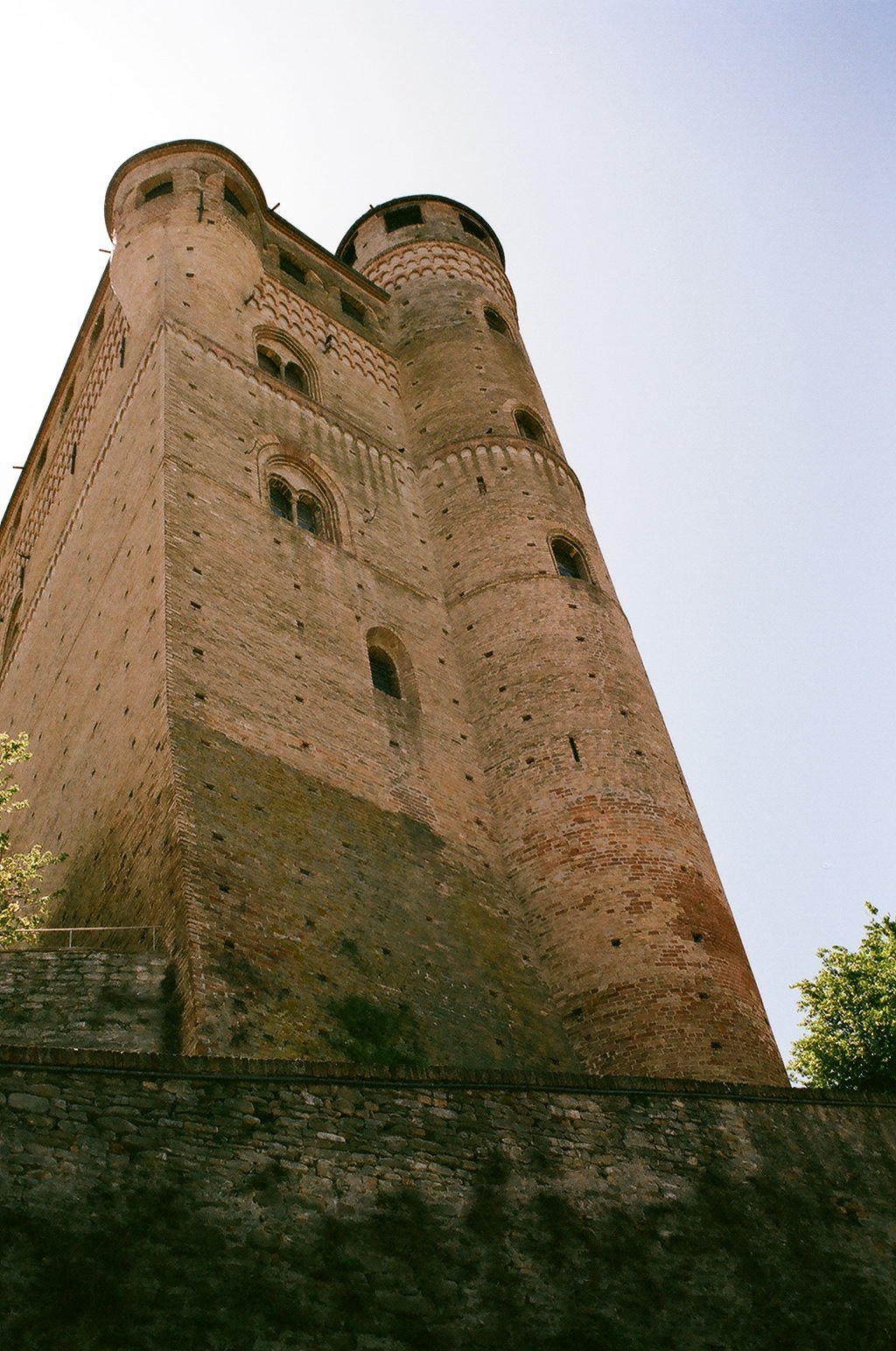
Le Torre di Barbaresco.
1. Marco e Vittorio Adriano
One of the first tastings was with wines from the cru vineyards of Rocche Massalupo at the town San Rocco Seno d’Elvio, a southern commune of Treiso. The house of Adriano, Marco e Vittorio, which have been making wines since the 1900s, presented a wine called Sanadaive, which I was told in local dialect to mean veins of sand and is also the local slang for the town of San Rocco Seno d’Elvio. The vineyard Rocche Massalupo is a slice of land that ranges from 250 to 450 feet above sea level, where the soil is made up of sand and marl containing components of limestone. The resulting wine was plush with ripe red berry, floral in its perfume, rich with bright structure and a firm tannic presence under sweet berry fruit. I expected a wine that would be more sinewy, but what I tasted was full fruit flavours. This was fine for a wine that had gone through fermentation and one year ageing in stainless steel before one year in large cask.
2. Rizzi
The next stop, moving toward the north, was at the cru vineyards of Nervo under the village of Treiso, located on steep slopes of white sand, calcaire and some sandstone. The 18th-century family estate of Rizzi (also the name of a cru vineyard) has only been making wine since the early 1970s. Enrico and Jole Dellapiana are leading the family business with Enrico as the winemaker and Jole as the director of sales and commercial relations. In fact, the Rizzi family of wines is one of the more significant large-scale producers in Barbaresco. From one of their three estates they presented the cru Nervo, a wine from a completely south-facing slope located at 375 feet above sea level shaped to form a natural amphitheatre. At first the wine was warm with an aroma of ripe strawberry to blue and black berry fruit, with a lean mineral tone. But on the palate the wine was gentler with the same sweet berry fruit taste and the introduction of classic forest floor and herbal elements. These wines go through fermentation in steel tanks and are then aged in oak barrels for one year with one further year in concrete tanks plus one year in the bottle before being released to market. Overall the cru Nervo was a full-bodied wine with some sweet coffee and vanilla tones, hinting at some new oak used.
3. Podere Colla.
A wine from Podere Colla, run by Pietro Colla, represented cru Roncaglie. The family prides itself on having farmed ‘naturally/organically’ many years prior to the ‘recent trend’, and is known for being the best grape grower historically and the most significant collaborator with the famous house of Prunotto (also run by Antinori of Tuscany) over the last 60 years, though it is only in the last 30 years that it has been making wine under the Colla family name. The 2011 Barbaresco cru Roncaglie is raised on soils of sand and limestone at 200 to 250 metres above sea level. I must note that Roncaglie wine was a force to be reckoned with and certainly needed time in bottle. On my first taste the wine was robust with fruit, wood spice and mint and the palate was firm with tannin and concentrated dark fruit. All in all, a classic and traditional wine: firm, big and bold. The vineyard’s proximity to the Tanaro River and the ripening effects and warmth it provides can certainly be felt in this wine.
4. Castello di Verduno.
The cru Rabaja from the Castello di Verduno was next up. The Rabaja vineyard for Barbaresco is as renowned as Cannubi is for Barolo. In the commune of Barbaresco, situated south to south east of the town of Barbaresco, Rabaja is known for producing enchanting wines from the steep south-west facing slopes. The afternoon and evening sun warms the vineyards, which are composed of limestone soil mixed with a significant amount of clay. The result is wines that can be powerful and structured. Wine-maker,Mario Andrion and owner, Marcella Burlotto of Castello di Verduno gave us a lesson in style and interpretation with the 2011. Open top fermentation for 40 days, then two years in neutral oak resulted in a wine that was bright, savoury and peppered with equal floral and berry aromas. The palate was fresh, with creamy red berry fruit that was lightly minted with tannin that was firm yet silky.
5. Luigi Giordana.
The cru Montestafano is known for long-lived wines. The site for Montestafano is due west of the town of Barbaresco and located on slopes facing south-east that are warmed by the morning sun but are cooler in the evening. The soil composition here has a fair amount of clay and the vineyards are often the first to be harvested, as the wines can often be intense and hard if grapes are left too long on the vines. The house of Luigi Giordana, founded in the 1930s, runs a small family winery producing 65,000 bottles. Luigi and his wife have been making serious wine since the 1960s. As of late, his daughters Laura and Silvia have been taking up the reins of the family business. The 2011 cru Montestefano was fresh berried in aroma with savoury and smoky notes. The palate offered up a sweet berry fruit taste intermingled with earthy and tobacco flavours, and the wine was a decidedly classic and mineral example of Barbaresco.
6. Castello di Nieve.
The cru Santo Stefano (a subzone of the cru Albesani) is entirely owned by Castello di Nieve, located in the Nieve commune, and has been under the guidance of the Stupino family since the late 1960s. The vineyard is of chalk and marl and, though rather close to the Tanaro River, the vineyard is in the shadow of the hill and is typically quite cool. Claudio Roggero, winemaker for the Castello since 1999, presented the wine, which I expected to be rather firm. My expectations were completely turned on their head by the wine’s ripe berry aromas and delicate red floral tones. The wine was quite generous with a rich full-body expression. Whereas many of the previous wines were aged in Slavonian oak, here we could see how the use of French oak barrel gave the wine an approachable feel, which I think provided a necessary counterpoint to the effects of the vineyard site and aspect.
To conclude, the Round Table Tasting at the Tower of Barbaresco highlighted six great producers who work well with the terroir and understand the unique quality of the unique microclimates. Each of them producing excellently crafted wines. Truly a well ‘rounded’ experience!
Such collaborations bode very well for a region that could benefit greatly from a joining of forces between its leading producers to promote and provide greater clarity for the buyer and the consumer.
 Christopher Sealy is the co-proprietor of Midfield Wine Bar as well as Manager/Sommelier at George Restaurant. Christopher will be penning a number of Piemontese pieces for Good Food Revolution over the coming months, with this Nebbiolo Prima article being his third.
Christopher Sealy is the co-proprietor of Midfield Wine Bar as well as Manager/Sommelier at George Restaurant. Christopher will be penning a number of Piemontese pieces for Good Food Revolution over the coming months, with this Nebbiolo Prima article being his third.




